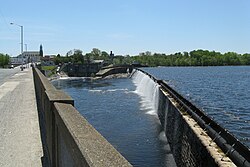Great Stone Dam
|
Great Stone Dam
|
|

Great Stone Dam
|
|
| Location | Lawrence, Massachusetts |
|---|---|
| Coordinates | 42°42′3″N 71°10′0″W / 42.70083°N 71.16667°WCoordinates: 42°42′3″N 71°10′0″W / 42.70083°N 71.16667°W |
| Built | 1848 |
| Architect | Storrow, Charles; Bigelow, Charles |
| Architectural style | Other |
| Part of | North Canal Historic District (#84000417) |
| NRHP Reference # | 77000184 |
| Significant dates | |
| Added to NRHP | April 13, 1977 |
| Designated CP | November 13, 1984 |
The Great Stone Dam (also called the Lawrence Dam or Lawrence Great Dam) was built between 1845 and 1848 on the site of Bodwell's Falls on the Merrimack River in what became Lawrence, Massachusetts. The dam has a length of 900 feet (270 m) and a height of 35 feet (11 m).
Lawrence is in Essex County, Massachusetts, approximately 25 miles (40 km) north of Boston and only a few miles south of the New Hampshire border (Salem), located in the Merrimack Valley. The dam is 11 miles (18 km) downstream from Lowell and is visible from Route 28 (Broadway) in Lawrence and from behind the Pacific Paper Mill (now defunct).
The dam feeds two canals (North, re-built in 1848, and South, completed in 1896). At their peak, the North Canal provided up to 13,000 horsepower and the South Canal 2,000 horsepower; the Essex Company sold "mill rights" to its water power, allowing mills to use the energy provided. The North Canal existed before the dam, but was redeveloped both to better feed the mills and to accommodate the 30-foot (9.1 m) drop caused by the dam. About a mile in length, the canal had a guard lock and three lift locks with mitered gates. The locks were abandoned in the 1960s.
Today the dam is the site of a hydroelectric plant, completed in 1981, which is owned by Enel (now parent company of the Essex Company, which still owns the dam). and the Lawrence Hydroelectric Associates.
In part due to the successful use of the river's power to develop the industrial potential of the city of Lowell, a consortium of local industrialists (Abbott Lawrence, Edmund Bartlett, Thomas Hopkinson of Lowell, John Nesmith, and Daniel Saunders) set out to create a "New City on the Merrimack", which would later become known as Lawrence.
...
Wikipedia


